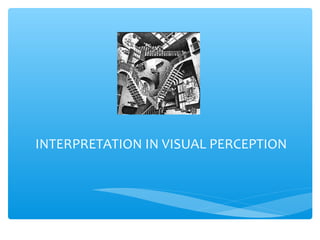
Perceptual set and illusions 2013
- 1. INTERPRETATION IN VISUAL PERCEPTION
- 2. PERCEPTUAL SET The predisposition / readiness to perceive stimuli in line with our expectations, ignoring other stimuli or other possible interpretations. Perceptual Set = Expectancy Various psychological factors create an EXPECTATION to organise &/or interpret information in a particular way. Turn to page 125 in your text and complete the simple activity
- 3. PERCEPTUAL SET Perceptual set can: ENHANCE visual perception by correctly anticipating a stimulus hence interpreting it more quickly Lead to MISINTERPRETATION of a stimulus by incorrect anticipation or expectation Perceptual set can be influenced by: Context Past Experience Motivation Emotional state Cultural factors
- 4. Perceptual Set CONTEXT ∗ The setting in which the stimulus occurs. ∗ The physical circumstances or surroundings in which the observed event or object occurs. ∗ The same behaviour or same event may be perceived differently depending on the circumstances in which it occurs. ∗ If we always see information in a particular context, this can create an expectancy that it will never be seen in another context.
- 5. Perceptual Set PAST EXPERIENCE The personal experiences we have experienced throughout our lives. These experiences are subjective (they are interpreted in very personal ways). The subjective interpretations are due to the individual’s intellectual capacity, personality traits, upbringing, attitudes & values. Every individual has a unique combination of past experiences, hence leading to individual differences in perception.
- 6. Perceptual Set MOTIVATION ∗ Relates to activating behaviour that is directed towards achieving a particular goal. ∗ They can be influenced by physiological factors (bodily functions eg. hunger) or psychological factors (interests or ambitions).
- 7. Perceptual Set EMOTIONAL STATE ∗ How we are feeling can influence the way in which we perceive visual information
- 8. Perceptual Set CULTURAL FACTORS ∗ Refer to the way of life of a particular community or group that sets it apart from other communitites and groups. (customs, traditions beliefs, attitudes, rules about right and wrong) ∗ Eg. remote tribal community – not understanding a photograph
- 9. Distortions of Visual Perception Distortions or mistakes in visual perception sometimes occur. Visual illusions demonstrate cases in which reality is misperceived. VISUAL ILLUSION: a misinterpretation of real sensory stimuli; there is a mismatch between our perception and what we understand as physical reality. PERCEPTUAL COMPROMISE: occurs when two or more visual cues conflict with each other when we are interpreting visual information, hence leading us to make a ‘compromise’ and settling on an interpretation that makes the ‘best sense’.
- 10. Illusions Muller-Lyer Illusion Perceptual Compromise we compromise the information about the length of the horizontal lines and the length of each whole figure.
- 11. Ames Room Illusion – Apparent depth or distance theory • Use of ONLY monocular cues, binocular cues are prevented from being used – Perceived size of the people in the room is determined by the image cast on the retina – We are tend to maintain shape constancy at the expense of size constancy
- 12. Other Illusions ∗ AMBIGUOUS FIGURES ∗ A visual stimulus that can be perceived in more than one way, with each different perception being equally accurate. ∗ The differing interpretations of the stimulus occur with shifts in attention and how we perceive the contour.
- 13. IMPOSSIBLE FIGURES A visual stimulus object that produces conflicting interpretations and is perceived on a 2-dimensional surface as being impossible in the real world (3-dimensional)